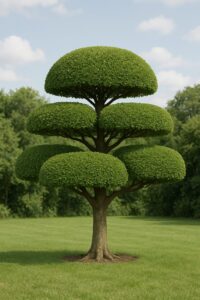 When people think of tree pruning, they often picture someone trimming back branches to make a tree look more symmetrical or neat. And while there’s nothing wrong with wanting a tidy landscape, the benefits of tree pruning go far beyond appearance. At New Day Arborist, we like to say: good pruning is proactive care—a vital part of ensuring the health, longevity, and safety of your trees and your property.
When people think of tree pruning, they often picture someone trimming back branches to make a tree look more symmetrical or neat. And while there’s nothing wrong with wanting a tidy landscape, the benefits of tree pruning go far beyond appearance. At New Day Arborist, we like to say: good pruning is proactive care—a vital part of ensuring the health, longevity, and safety of your trees and your property.
Whether you’re a homeowner trying to protect your family or a property manager maintaining a healthy urban canopy, understanding the full purpose of pruning can help you make smarter, more informed decisions about your trees.
🌳 What Is Tree Pruning, Really?
Tree pruning is the selective removal of branches or stems to benefit the whole tree. This process involves much more than snipping at random; it requires:
-
Knowledge of tree species
-
Understanding of growth patterns
-
Awareness of timing, structural integrity, and long-term goals
Pruning can target deadwood, improve airflow, shape the canopy, remove hazards, and stimulate healthy growth—depending on what the tree needs and when.
✅ 1. Pruning Promotes Tree Health
Much like a haircut can encourage hair growth and eliminate split ends, pruning helps trees thrive by:
-
Removing dead, diseased, or pest-infested branches
-
Improving sunlight penetration and air circulation
-
Reducing the risk of fungal infections and decay
Think of it as removing the weak links in the system. When unhealthy limbs are eliminated, the tree can redirect nutrients to healthier parts, making it more resilient and vibrant overall.
Example:
If a branch is infected with anthracnose or has become a haven for boring insects, pruning it early can stop the spread and preserve the rest of the tree.
⚠️ 2. Pruning Protects People and Property
One of the most critical reasons to prune is safety. Overgrown, cracked, or weakened branches are ticking time bombs—especially in windstorms or heavy snow.
Proper pruning:
-
Prevents branches from falling onto homes, driveways, fences, or power lines
-
Reduces the chance of limb failure in high winds
-
Keeps trees from interfering with structures or blocking sightlines
At New Day Arborist, we perform risk assessments before pruning to identify high-stress limbs and structural weaknesses that may not be obvious to the untrained eye.
🌱 3. Pruning Encourages Stronger Growth and Structure
Especially for young trees, pruning is a vital tool for training a strong, balanced structure. By guiding how branches grow from an early age, you prevent future problems like:
-
Narrow branch unions
-
Weak crotches
-
Top-heavy canopies
In older trees, careful pruning can correct imbalances, such as overextended limbs or multiple competing leaders (main stems), which increase the risk of splitting.
Fun fact:
Did you know that proper pruning can extend a tree’s life by decades? It reduces internal stress and allows for efficient growth.
🍎 4. Pruning Increases Fruit Production (for Certain Trees)
If you have fruit trees on your property, regular pruning isn’t just helpful—it’s essential. Unpruned trees often:
-
Produce smaller, less abundant fruit
-
Suffer from overcrowded branches and poor air circulation
-
Become more susceptible to pests and disease
Strategic pruning opens up the canopy, allowing sunlight to penetrate and reach the fruit-bearing limbs. It also encourages new shoots, which are typically more productive.
🌼 5. Yes, It Also Improves Curb Appeal
We’d be remiss not to mention the visual benefits. Thoughtful pruning enhances the natural beauty of a tree, helps it complement your home or landscape, and can even:
-
Increase property value
-
Highlight seasonal interest (like flowering limbs or colorful fall foliage)
-
Frame views or provide strategic shade where you want it
But again—this isn’t about over-shaping a tree into a lollipop. Good pruning respects the tree’s natural form while refining its appearance and function.
✂️ Don’t DIY—Why Professional Pruning Matters
We get it—grabbing a saw and tackling that overhanging branch yourself might feel like a Saturday well spent. But improper pruning can lead to:
-
Wounds that don’t heal
-
Increased risk of disease or rot
-
Structural instability
-
Unsightly regrowth (such as water sprouts)
Certified arborists are trained in species-specific pruning techniques. At New Day Arborist, we prune with long-term health in mind, using clean cuts, proper timing, and best practices for each tree.
We also follow ANSI A300 standards, the industry benchmarks for safe and effective pruning.
🕒 When Is the Best Time to Prune?
It depends on the tree species and your goals:
| Purpose | Best Time to Prune |
|---|---|
| General health & maintenance | Late winter to early spring |
| Disease management | When trees are dormant (winter) |
| Flowering enhancement | After blooming (for spring-flowering trees) |
| Safety or hazard pruning | Any time, especially before storm season |
Need help figuring it out? We’re happy to walk your property and make a custom plan.
🌳 Let’s Give Your Trees the Care They Deserve
Tree pruning isn’t a luxury—it’s a vital part of responsible tree care. At New Day Arborist, we view every pruning job as a partnership with nature: helping trees live longer, look better, and stay safer.
Whether you have a single ornamental maple or a grove of aging oaks, our team is ready to bring out the best in your trees—with precision, care, and a deep respect for their role in your landscape.
📞 Schedule a Professional Tree Pruning Assessment
Ready to prune with purpose? Contact New Day Arborist today to schedule an on-site assessment. Your trees—and your future self—will thank you.